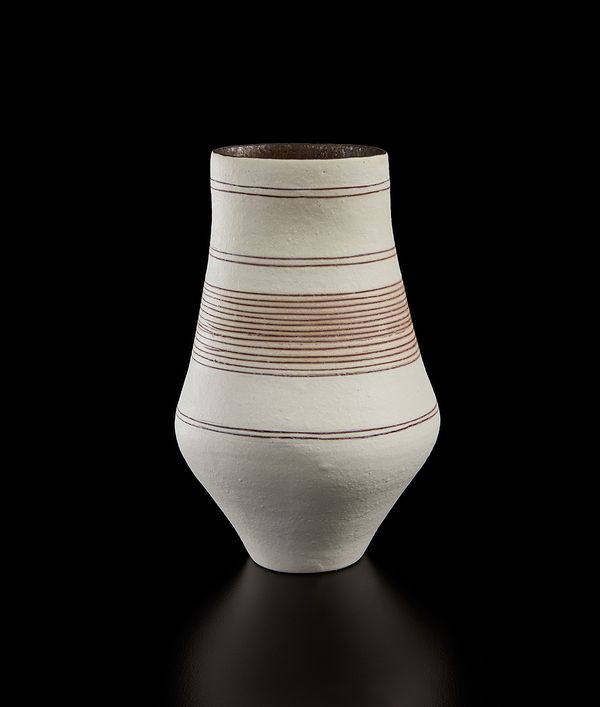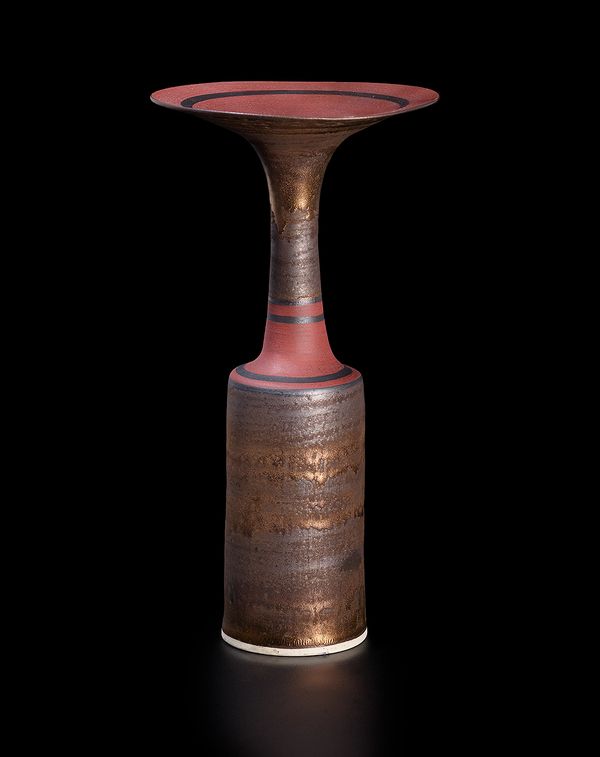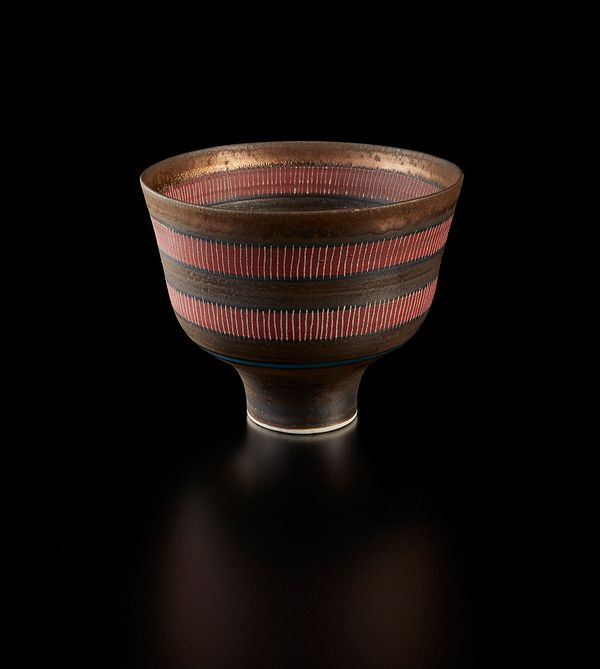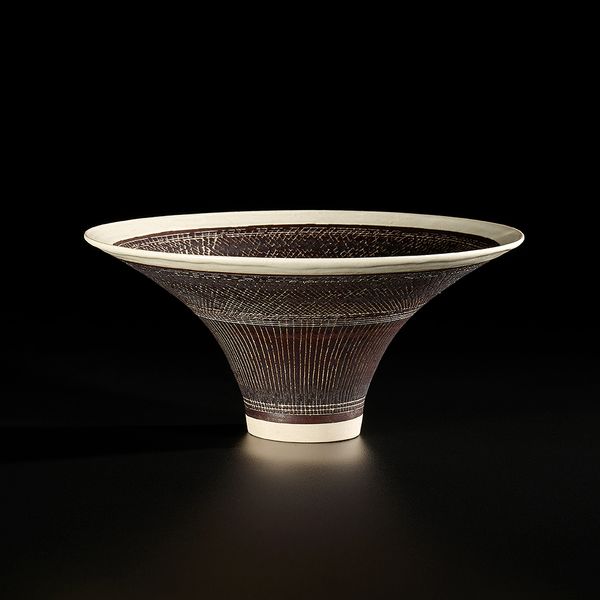Lucie Rie in her studio at Albion Mews, 1980s. Photo © Mrs Yvonne Mayer / Crafts Study Centre, University for the Creative Arts, UK. Reference number: RIE/20/1/11.
The visual and tactile diversity of the many pots that Lucie Rie produced through her long creative life is one of the remarkable aspects of her work. Her own identity was in all of them, despite their differences of touch, color, weight, purpose, and form.
The ten pieces on offer from the estate of journalist Claire Frankel give an insight into some of these periods, though a number of them are focused on the bowls and fine bottle forms and her sgraffito surface, where she cut fine lines through a layer of manganese glaze back to the pure white surface underneath. The glaze was painted onto the unfired brittle porcelain clay form, and she scratched her lines through it with a fine steel point. So many of her habitual processes were found through her own discoveries. Her extensive testing and material experiments ran a continuous research thread through the decades of her production in her London studio. This intriguing place, in a backstreet mews near the West End of the city, was a delight to visit, which I did on a few occasions. After her death, her importance to British culture was such that her studio was photographed in detail by The Royal Commission for Historic Buildings, in 1995.
The situation during the 1970s in which Lucie Rie was teaching a little at Camberwell Art School, and her close associate, Hans Coper, taught for a day a week at the Royal College of Art, opened an understanding of a European sensibility in the art of ceramics to numerous students in a most significant way. They fostered a new wave in the culture and history of ceramics in Britain. As another luminary of the 1950s and 60s, William Newland, said: “It's not that we were anti‐Leach, but there were other things to do...”. Where Leach found the Sung "standard" impossible to overlook, as well as Korean pottery, English medieval pots and vernacular slipware, Rie and Coper found more to excite them in ancient Mediterranean art–Roman, Mycenaean, Cycladic.
Lucie Rie, Vase with oval lip, circa 1976. Estimate: $12,000 - 18,000. Design at Phillips New York, 29 July.
Lucie Rie's Vase with oval lip (circa 1976) has a white unglazed porcelain exterior but the inside is glazed with her golden manganese glaze, a dark interior that we see little of. But it has the calibrated form reminiscent of a human figure, and the choice she has made, instinctively for sure, about where to incise her linear bands enhances this human reference, the vase is swelling out to the hips. You can feel the background of The British Museum's Mediterranean collections in her vocabulary.
Lucie Rie, Cylindrical vase with flaring lip, circa 1978. Estimate: $20,000 - 30,000. Design at Phillips New York, 29 July.
A few years later Rie made Cylindrical vase with flaring lip (circa 1978), a narrow bottle form, of great precision. Using her wet hands and a few long tools, the precise control of such a slender hollow form is startling. Though only 25 cm high, it has a strong presence, due in part to the unusual terracotta red matte glaze, which shows on the wide lip of the vase and again on the shoulder of the very slender form. The smooth matte red contrasting with the glistening manganese glaze, and the surprise of the pure white porcelain foot ring, are characteristic of her palette of surfaces, that she developed to such an expressive range. The business she established to make thousands of ceramic buttons for the fashion trade, during and after the war, gave her a wonderful legacy of glaze knowledge and the confidence to experiment further.
Lucie Rie, Footed bowl, circa 1978. Estimate: $25,000 - 35,000. Design at Phillips New York, 29 July.
In making Footed bowl (circa 1978), Rie is using the same duo of glazes on this open form with a slender foot, with the addition of another bright contrast – a turquoise blue glaze that is banded inside the well of the bowl, and also on the outside surface as the curve narrows into the foot. The bands of dry red glaze on the outer and inner surfaces have a pattern of scratched parallel stripes cutting back to the white porcelain body. These fine vertical lines have the perfect imperfection of a steady human hand, with its lively variation.
Lucie Rie, Large vase with flaring lip, circa 1972. Estimate: $15,000 - 20,000. Design at Phillips New York, 29 July.
A much softer version of her bottle form, Large vase with flaring lip (circa 1972), has an ovoid body, a graceful shoulder curve and a long neck flaring out into a wide shallow disc. The porcelain has other colors worked into its mass, so that the process of throwing the lump on the wheel, and pulling up the bottle shape and neck, creates a loose spiral of different tones, that looks organic and spontaneous. The colors are soft like those of a mushroom, with hints of green and pink.
Lucie Rie, Footed bowl, circa 1960. Estimate: $40,000 - 60,000. Design at Phillips New York, 29 July.
The last piece I want to draw attention to is an earlier one from circa 1960. This is Footed bowl and brings us back to the sgraffito lines through a manganese glaze. The rim and the foot are white glazed, but the interior and exterior of the sharply flaring bowl form spring out from the foot in a concave arc. Six variations of the scratched pattern, with parallels, stripes and cross hatching, complete the exterior surface, including a band of impressed dots near the foot. So much variety is achieved within the modest palette of metallic brown and white. This is a beautifully tense and simple form, and speaks so much of wheel throwing and turning.
Lucie Rie worked for so many decades, and made so many kinds of pots, we can grow old getting to know the different phases of her search.
Alison Britton was part of the radical group of Royal College of Art (RCA) graduates in the early 1970s whose work was later known as “The New Ceramics.” Working from her London studio for four decades, Britton also writes and curates. She was awarded an OBE in 1990, taught in the Ceramics and Glass department of the RCA until 2018, and received an Honorary Doctorate there from the RCA in 2019.





